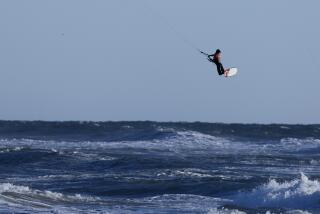Successful Kite Lives With Failure
CARLSBAD — Perhaps they should call him Rodney. He must wonder what a fellow has to do to get a kind word.
Tom Kite in 1989 had the kind of year a golfer only dreams about:
--He won more money--$1,395,278--than any player in the history of golf.
--He became the all-time leading money winner--$5,600,691 earned with a golf stick.
--He won his 11th, 12th and 13th tournaments.
--He was third in scoring average.
--He finished second for the 17th time in his career.
--He was in the top 10 finishers 10 times.
--He won his Ryder Cup match 8 and 7, which is the golf equivalent of a 2-hit shutout.
--He was player of the year, man of the hour. Chipper and putter of the decade.
He did all this wearing owl-sized eyeglasses and sporting a physique that, at 5 feet 8 and 155 pounds, is considerably short of linebacker stature.
So they give him a ticker-tape parade, keys to the city, a reception at the White House, audience with the Pope and scheduled a movie about his life starring Robert Redford or Sly Stallone, right?
Wrong. Forget it.
They looked up at Tom Kite in the press room down here at the 38th Annual MONY Tournament of Champions and they said, “Uh, er, ah, Tom, about the U.S. Open at Rochester last year. Want to tell us about it?”
Kite winced.
It reminded idiotically of the story of the mother whose son was drowning and she was screaming for help. When someone dived into the riptide to rescue him and bring him back, the lady glared.
“He had a hat!” she snapped.
Tom Kite lost the hat at Rochester. With only 14 holes left to play in the U.S. Open there, he had a three-stroke lead, was playing his usual consistent, unruffled, down-the-middle game when, all of a sudden, the ball began coming off the club head sideways.
It looked like the worst case of Open nerves since Sam Snead in 1939. It was like watching a baby carriage roll downhill into the water. It hurt to look. The wheels began to fly off his game. Kite paled and got the look on his face of a guy who has just seen the eyes move in the castle wall portrait.
He stumbled to a 78. He joined that forlorn company of players who blew the Open.
Actually, he is in some pretty good company. Besides Snead in ‘39, there were Ben Hogan in ‘55, Arnold Palmer in ‘66, Jack Nicklaus in ’71.
Only rarely does somebody win an Open. It’s a tournament someone loses. It serves up victims, not victors.
And ’89 was Tom Kite’s turn in the barrel. It will color his life.
You have to be a pretty good player to blow the Open. Sam Snead won more tournaments than anybody who ever played the game but the Open wasn’t one of them. And that’s the first thing anybody ever remembers about Sam Snead. It’ll be on his headstone.
Tom Kite knows the feeling. As he took his seat before the lord high inquisitors of the press down here, the knights of the keyboard went right past his accomplishments in ’89 and went unerringly to the bad news.
Had ’89 on balance been a disappointment for him?
Tom looked incredulous.
“Hey, fellows, I just had the most incredibly successful year of my career, one of the most successful anyone ever had. I hit a lot of good shots.”
The press was courteous. But relentless. What about the not-so-good shot--the one that went soaring into the water on No. 5 at Oak Hill?
Actually, the shot that cost Tom Kite the Open at Oak Hill would have been better if it had been worse. A short time later, his playing partner, Scott Simpson, hit a worse right-to-right shot. But his was so bad it came to rest out in the open. He had a shot to the green. Kite’s shot was just bad enough to have double-bogey written all over it.
It reinforces the well-known adage that golf, like life, is not fair.
But the point to remember is that Tom Kite did not don a false mustache and dark glasses and sneak out of town to drown his disappointment, sob his heart out, smash his clubs, blame the government or look for someone else to blame. He didn’t even duck the press. He went manfully into the interview room that night and faced the music like the captain of the Titanic describing the iceberg.
Two weeks later, he was back on a tee. He played creditably in the Western Open, where he won $18,667 and finished 11th. Like a World War I pilot, he went right back up to a dogfight.
It is the mark of a champion that he can shrug off disappointment and carry the fight to his opponent. Hogan had a 12 on a hole in a Jacksonville Open once. And made a two on the next hole.
Pitchers who serve up gopher balls have been known to strike out the next batter. Fighters get off the floor to win.
If you play golf for a living, you do well to treat disaster as an imposter, not a permanent part of the family. There are times when even the greatest players cannot break 80.
The trick would be to save your cataclysms for the Bank of Boston Classic or the K mart Greater Greensboro Open when the whole world isn’t looking. Don’t hit the ball in the water in the Masters, as Seve Ballesteros does, or in the Open, as Tom Kite did.
Golfers relate to the Tom Kite and Ballesteros and Snead, empathize with their shipwreck shots. They know all too well what can happen when ball meets hosel instead of club face.
It’s reassuring to know it can happen to a guy who is playing the best golf out there these days.
But Tom Kite, who last year hit some of the best shots anybody has ever hit, must still answer for the one shot that didn’t come off. One journalist cut right through the tournaments won, the money won, the trophy standings and said, accusingly, “Do you feel the Open owes you one?”
Kite sighed.
“Golf doesn’t owe you a thing,” he said. “It’s a cruel game. Look at this. The best year of my life is also, in a way, the most disappointing. I get asked about the one that got away, not the ones hanging on my wall.”
That tells you all you need to know about golf. As someone said, it’s not a game, it’s a sentence. You don’t win it, you survive it. Every tournament is like getting on the Hindenburg.
More to Read
Go beyond the scoreboard
Get the latest on L.A.'s teams in the daily Sports Report newsletter.
You may occasionally receive promotional content from the Los Angeles Times.










